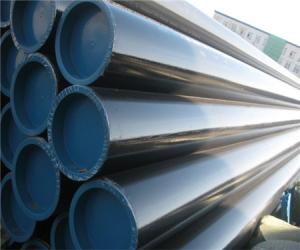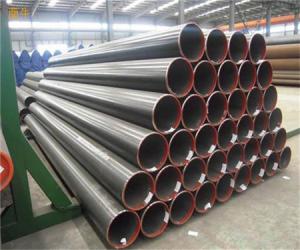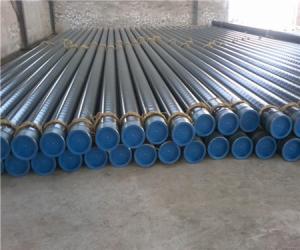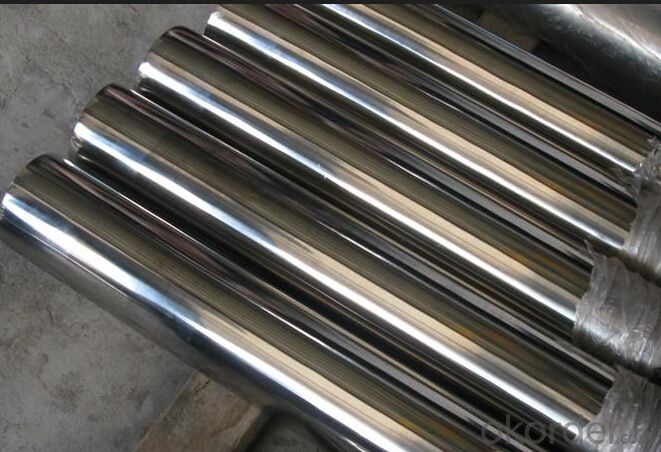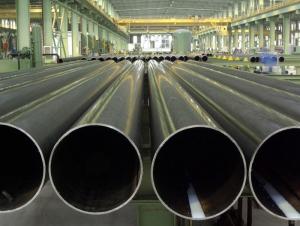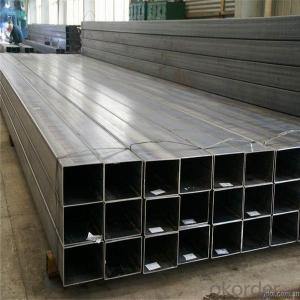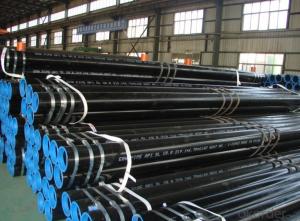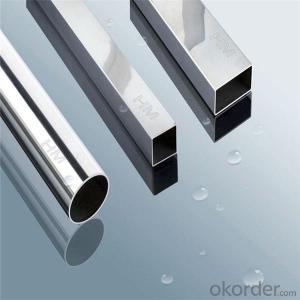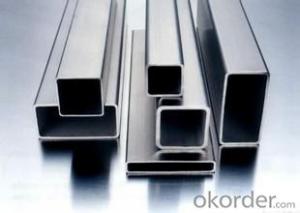Welded Stainless Steel Tube/Pipe Manufacturer
- Loading Port:
- China Main Port
- Payment Terms:
- TT or LC
- Min Order Qty:
- 30 kg
- Supply Capability:
- 12000 kg/month
OKorder Service Pledge
OKorder Financial Service
You Might Also Like
1、Structure of Seamless Pipe ASTM A106/53:
Seamless pipe is formed by drawing a solid billet over a piercing rod to create the hollow shell. As the manufacturing process does not include any welding, seamless pipes are perceived to be stronger and more reliable. Historically seamless pipe was regarded as withstanding pressure better than other types, and was often more easily available than welded pipe.
Application
carbon seamless steel pipes are widely used in gas, water and oil, transpotation;constructions;Bridge,highway,windows of model steel door; building materials;fences;heating facilities Fluid Pipe;conduit pipe,scaffolding pipe.etc.
Payment Terms: L/C D/A D/P T/T
Packing and shipment
Packaged in bundles,as per customers' requirements, it can also bepackagesd as beveled ends, typed marking, black painting, plastic caps protection,woven bags packing
For 20" container the max length is 5.8m; For 40" container the max length is 12m. other options are available based on customer requests. Please discuss when placing orders.
2、Main Features of the Seamless Pipe ASTM A106/53:
• High manufacturing accuracy
• High strength
• Small inertia resistance
• Strong heat dissipation ability
• Good visual effect
• Reasonable price
3、Seamless Pipe ASTM A106/53 Specification:
Standard | GB, DIN, ASTM ASTM A106-2006, ASTM A53-2007 |
Grade | 10#-45#, 16Mn 10#, 20#, 45#, 16Mn |
Thickness | 8 - 33 mm |
Section Shape | Round |
Outer Diameter | 133 - 219 mm |
Place of Origin | Shandong, China (Mainland) |
Secondary Or Not | Non-secondary |
Application | Hydraulic Pipe |
Technique | Cold Drawn |
Certification | API |
Surface Treatment | factory state or painted black |
Special Pipe | API Pipe |
Alloy Or Not | Non-alloy |
Length | 5-12M |
Outer Diameter | 21.3-610mm |
Grade | 20#, 45#, Q345, API J55, API K55, API L80, API N80, API P110, A53B |
Standard | ASME, ASTM |
1) Material:20#(ASTM A 106/A53 GRB.API5LGRB,GB),45#,16Mn,10#.
2) Specification range:OD:21.3-610mm,WT:6-70mm,length:6-12m or according to the requirement of clients.
3) Excutive standards:GB,ASME API5L.ASTM A 106/A53,Despite of the above standards,we can also supply seamless steel pipe with standard of DIN,JIS,and so on,and also develop new products according to the requirements of our clients!
4) Surface:black lacquered,varnish coating or galvanized.
5) Ends:Beveled or square cut,plastic capped,painted.
6) Packing:bundles wrapped with strong steel strip,seaworthy packing.
4、Packaging & Delivery
Packaging Details: | seaworthy package,bundles wrapped with strong steel strip |
Delivery Detail: | 15-30days after received 30%TT |
5、FAQ of Seamless Pipe ASTM A106/53:
①How is the quality of your products?
Our products are manufactured strictly according to national and internaional standard, and we take a test
on every pipe before delivered out. If you want see our quality certifications and all kinds of testing report, please just ask us for it.
Guaranteed: If products’ quality don’t accord to discription as we give or the promise before you place order, we promise 100% refund.
②How about price?
Yes, we are factory and be able to give you lowest price below market one, and we have a policy that “ for saving time and absolutely honest business attitude, we quote as lowest as possible for any customer, and discount can be given according to quantity”,if you like bargain and factory price is not low enough as you think, just don’t waste your time.Please trust the quotation we would give you, it is professional one.
③Why should you chose us?
Chose happens because of quality, then price, We can give you both.Additionally, we can also offer professional products inquiry, products knowledge train(for agents), smooth goods delivery, exellent customer solution proposals.Our service formula: good quality+good price+good service=customer’s trust
SGS test is available, customer inspection before shipping is welcome, third party inspection is no problem.
6、Seamless Pipe ASTM A106/53 Images:
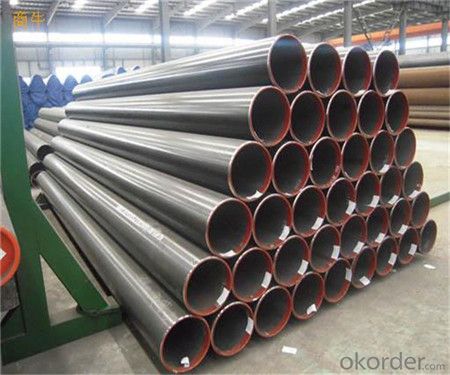
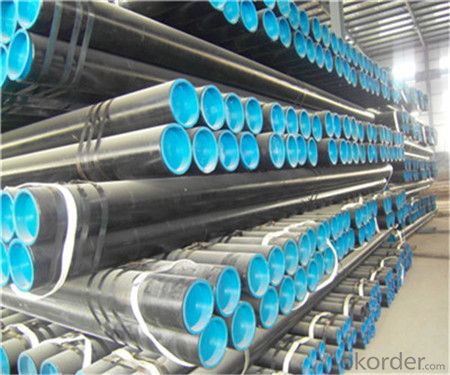
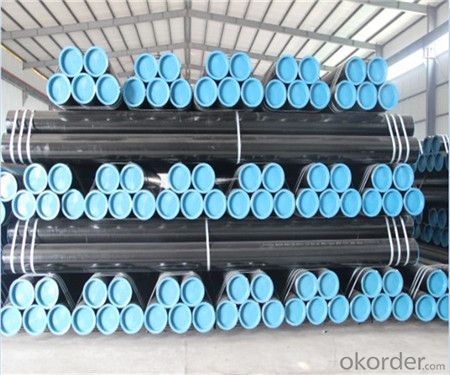
- Q: Can stainless steel pipes be used for dairy industries?
- Yes, stainless steel pipes can be used for dairy industries. Stainless steel is a popular choice for piping in dairy industries due to its many desirable properties. Stainless steel pipes are corrosion-resistant, which is crucial in the dairy industry where exposure to acids and other corrosive substances is common. They are also easy to clean and maintain, which is important for maintaining hygienic conditions in dairy processing plants. Additionally, stainless steel pipes are non-reactive, meaning they do not interact with the dairy products and alter their taste or quality. Furthermore, stainless steel pipes have high strength and durability, making them suitable for the high-pressure and high-temperature conditions often found in dairy processing. Overall, stainless steel pipes are a reliable and efficient choice for the dairy industry.
- Q: What is the difference between Type 304L and Type 316L stainless steel pipes?
- Type 304L and Type 316L stainless steel pipes are commonly chosen for a variety of uses due to their ability to resist corrosion. However, they differ in their composition and performance in specific settings. The primary distinction lies in their alloy content. Type 304L stainless steel contains 18-20% chromium and 8-12% nickel, whereas Type 316L stainless steel contains 16-18% chromium, 10-14% nickel, and 2-3% molybdenum. The inclusion of molybdenum in Type 316L enhances its corrosion resistance, particularly in environments with high chloride concentrations. As a result, Type 316L is more suitable for applications where the pipes will come into contact with seawater, brine, or other harsh chemicals. Another factor that sets them apart is their mechanical properties. Type 316L stainless steel has slightly higher tensile strength and yield strength compared to Type 304L. It also exhibits better creep and stress rupture properties, making it more appropriate for high-temperature uses. However, for most general purposes, Type 304L is still a good choice, offering excellent durability and longevity. When it comes to cost, Type 316L stainless steel pipes are typically more expensive than Type 304L due to the additional alloying elements. Therefore, the decision between the two will depend on the specific requirements of the application, taking into account factors such as the corrosive environment, temperature, and budget. Overall, while both Type 304L and Type 316L stainless steel pipes provide excellent corrosion resistance, Type 316L offers superior performance in more aggressive environments and higher temperatures. It is advisable to consult with a materials expert or engineer to determine the most suitable stainless steel pipe for a particular application.
- Q: What is the difference between 321 and 316 stainless steel pipes?
- The main difference between 321 and 316 stainless steel pipes lies in their composition and applications. 321 stainless steel contains titanium, which helps improve its resistance to intergranular corrosion and high temperatures, making it suitable for applications in the aerospace and automotive industries. On the other hand, 316 stainless steel is more corrosion-resistant overall and is commonly used in marine environments or for applications involving exposure to chemicals or saltwater.
- Q: How do stainless steel pipes compare to other materials like carbon steel or PVC?
- When it comes to various applications, stainless steel pipes have several advantages over other materials such as carbon steel or PVC. Firstly, stainless steel pipes are well-known for their excellent corrosion resistance. They can resist rust, oxidation, and staining, making them suitable for use in environments with high moisture or chemical exposure. In contrast, carbon steel pipes are prone to corrosion and require protective coatings to prevent rusting, while PVC pipes are not resistant to certain chemicals and can degrade over time. Secondly, stainless steel pipes provide exceptional strength and durability. They can withstand high pressure and extreme temperatures, making them ideal for applications that require robust and long-lasting piping systems. Carbon steel pipes also have good strength characteristics, but they may not be as corrosion-resistant as stainless steel. On the other hand, PVC pipes are relatively weaker and may not be suitable for high-pressure applications. Furthermore, stainless steel pipes have excellent hygienic properties. They are non-porous, smooth, and easy to clean, making them suitable for use in industries such as food and beverage, pharmaceuticals, and healthcare, where cleanliness and prevention of bacterial growth are crucial. Carbon steel pipes, due to their porous nature, can accumulate contaminants and bacteria over time. PVC pipes, although easy to clean, may release certain chemicals into the water or fluids passing through them, which can be a concern in certain applications. Lastly, stainless steel pipes are highly versatile. They can be used in a wide range of applications, including water supply, gas pipelines, chemical processing, oil and gas exploration, and architectural purposes. Carbon steel pipes are also versatile but may require additional measures to prevent corrosion. PVC pipes, while suitable for certain applications, have limitations in terms of temperature and pressure ratings. In summary, stainless steel pipes offer superior corrosion resistance, strength, durability, and hygienic properties compared to carbon steel or PVC pipes. When choosing a piping material, it is important to consider the specific requirements of the application to ensure optimal performance and longevity.
- Q: Can stainless steel pipes be electropolished?
- Certainly, electropolishing is a viable option for stainless steel pipes. It is a widely employed technique aimed at improving the surface quality of stainless steel by eliminating imperfections and pollutants. This method entails submerging the stainless steel pipe in an electrolyte solution and administering an electrical current to it. As a result, a thin layer of material is selectively eradicated from the surface, yielding a polished and lustrous appearance. Electropolishing proves especially advantageous for stainless steel pipes employed in sectors such as pharmaceuticals, food processing, and semiconductors, where an elevated standard of surface cleanliness and resistance to corrosion is indispensable.
- Q: Can stainless steel pipes be cold worked?
- Yes, stainless steel pipes can be cold worked. Cold working is a process in which the metal is deformed at room temperature, typically through processes like bending, drawing, or rolling. Stainless steel's excellent mechanical properties and ductility make it well-suited for cold working, allowing for the creation of complex shapes and designs while retaining its strength and corrosion resistance.
- Q: What is the yield strength of stainless steel pipes?
- The yield strength of stainless steel pipes can vary depending on the specific grade of stainless steel used. However, most commonly used grades of stainless steel pipes have a yield strength ranging between 25,000 to 100,000 pounds per square inch (psi).
- Q: Can stainless steel pipes be used for underground gas lines?
- Indeed, underground gas lines can utilize stainless steel pipes. Renowned for their impressive resistance to corrosion, stainless steel pipes prove to be an apt selection for underground scenarios wherein moisture and diverse chemicals prevalent in the soil pose a threat. Moreover, these pipes exhibit a remarkable strength-to-weight ratio, rendering them sturdy enough to endure the pressure and environmental circumstances linked to underground gas lines. Furthermore, stainless steel pipes boast an extended lifespan and necessitate minimal upkeep, thus emerging as an economical and dependable choice for subterranean gas distribution systems.
- Q: Can stainless steel pipes be insulated with polycarbonate?
- Insulating stainless steel pipes with polycarbonate is not possible. Polycarbonate is a thermoplastic material known for its transparency, impact resistance, and insulation capabilities. While it can insulate some pipes like PVC or copper, it is not suitable for stainless steel pipes. These pipes are typically used in high-temperature or corrosive environments, necessitating insulation materials that can withstand such conditions. It is advisable to opt for insulation materials specifically designed for stainless steel pipes, such as mineral wool, fiberglass, or foam pipe insulation.
- Q: What are the connecting methods of stainless steel pipes for indoor water pipes?
- Card type features: easy to install, connecting the external pipe, the internal rubber ring is evenly compressed into hexagonal. Scope of application: cold water system, pipe direct drinking water system, and more suitable for pipe installation. The utility model has the advantages that the connection is simple and convenient, the working hours are short, and the cost is moderate. Drawback is the single application, the maintenance of trouble, both the pipe sealing ring in aging and need to be replaced more trouble, because the connection was stuck, replacement is the need to both ends of the pipe to replace the sawing.
Send your message to us
Welded Stainless Steel Tube/Pipe Manufacturer
- Loading Port:
- China Main Port
- Payment Terms:
- TT or LC
- Min Order Qty:
- 30 kg
- Supply Capability:
- 12000 kg/month
OKorder Service Pledge
OKorder Financial Service
Similar products
Hot products
Hot Searches
Related keywords

